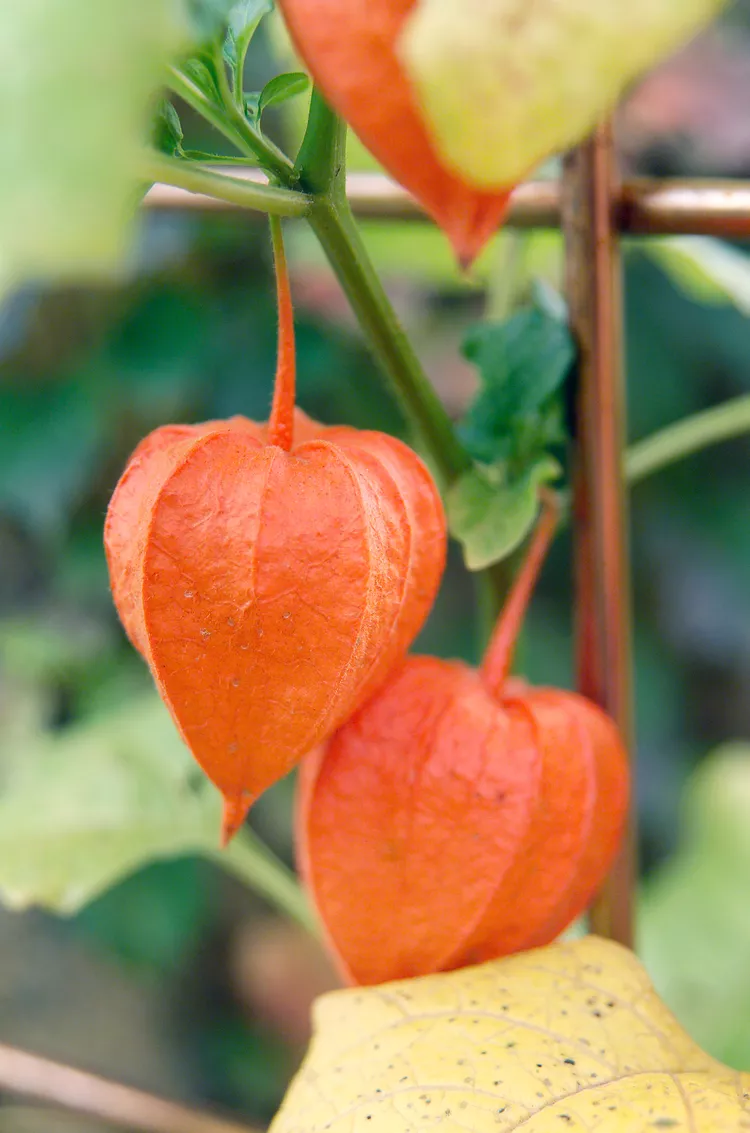Take one look at a Chinese lantern plant in autumn, and you'll see where it got its name. After the small white blooms fade, the plant is covered with bright orange husks that look like tiny paper lanterns. Native to Asia and Southern Europe, Chinese lantern plants are members of the nightshade family, along with tomatoes, eggplants, and peppers. Here's what you need to know to grow this plant in your garden.
Most parts of Chinese lantern plants are toxic to both pets and humans. Don't consume the unripe fruits, leaves, or any other parts of the plant. However, the ripe fruits are edible, but only when they're so ripe they fall off the plant.
Chinese Lantern Overview
| Genus Name | Physalis alkekengi (syn. Alkekengi officinarum) |
| Common Name | Chinese Lantern |
| Additional Common Names | Ground cherry, Winter cherry, Strawberry tomato |
| Plant Type | Perennial |
| Light | Part Sun, Sun |
| Height | 1 to 2 feet |
| Width | 1 to 2 feet |
| Flower Color | White |
| Foliage Color | Blue/Green |
| Zones | 6, 7, 8, 9 |
| Propagation | Division, Seed |
| Problem Solvers | Deer Resistant |
Where to Plant Chinese Lantern
Plant Chinese lanterns in an area of your garden (or in a container) that receives full sun. If you live in a place with a scorching hot summer, choose a location that receives some shade in the afternoon so the foliage doesn't burn. Although you can plant them directly in a garden bed of well-draining soil, these plants have rhizomes that spread easily and can quickly take over the garden. Plant them in pots to contain their invasive tendencies. They grow in USDA Zones 6–9.
How and When to Plant Chinese Lanterns
Plant Chinese lantern seeds in the spring after the last frost. Although cold stratification is not required, a period of 14 cold days (outdoors or in the fridge) significantly improves the germination rate. Then, soak the seeds in water for 24 hours before sowing them on prepared soil. Cover the seeds with 1/8 inch of soil and tamp down the surface. The seeds germinate in two to three weeks in warm, moist soil. After they germinate, thin the seedlings to 2 feet apart.
For an earlier start, sow the seeds indoors 1/8 inch deep in seed-starting mix about six weeks before the last frost. Keep them in a brightly lit room at 70°F-75°F. After the weather warms, transplant the seedlings outside to a prepared bed or container.
These plants grow quickly and bloom the same year of planting. Small white flowers appear in the summer before turning into decorative orange-to-reddish husks that resemble lanterns.
Chinese Lantern Plant Care Tips
Chinese lanterns are easy to care of as long as they aren't allowed to spread into the garden.
Light
Chinese lanterns thrive in full sun, so plant them in a south or west-facing area. These plants can also grow in partial afternoon shade, which is beneficial when the climate is hot.
Soil and Water
Chinese lanterns like well-draining soil with a pH that ranges from 6.6 to 7.3. Soil with lots of organic matter encourages the plant to thrive—but also spread. One way to minimize spread is to plant in average soil that hasn't been enriched.
This plant likes consistently moist, but never soggy, soil. Overwatering can lead to root rot.
Temperature and Humidity
These warm weather plants do best with daytime temperatures around 70°F during the day and nighttime temperatures that don't dip below 55°F. Make sure to plant after the last frost to ensure success, as the plant dies back in cold weather or during frosts. It has no humidity preference.
Fertilizer
Fertilize in the spring when you see new growth. Apply slow-release, balanced fertilizer, following the product directions. If the plant is growing fast and spreading, you may want to avoid using fertilizer.
Pruning
Pruning isn't necessary, but pruning the smaller branches encourages more plant growth. Avoid pruning Chinese lantern plants while they're blooming.
Potting and Repotting Chinese Lantern
Chinese lantern is an excellent candidate for outdoor container growing. Choose a 2-foot or larger, well-draining container and fill it with potting soil or average garden soil enhanced with compost. Either sow seeds or add transplants to the container and thin to the strongest one or two plants as they grow. The plant is a perennial that dies back for winter and regrows each spring. There is no need to repot it with fresh soil each year.
Pests and Problems
Many pests can attack or create a home in a Chinese lantern plant. Different varieties of beetles can be a problem, so watch for cucumber beetles, flea beetles, and false potato beetles. One way to know you have a pest issue is to check for holes in the leaves. If there's an infestation, treat the entire plant—leaves, husks, and stem—with neem oil.
Fungal diseases can also affect the plant. Avoid overcrowding plants and ensure there is good air circulation to prevent diseases.
How to Propagate Chinese Lantern Plant
You can propagate Chinese lanterns in two ways—with seeds or division. When the plant goes to seed, collect, dry, and store the seeds to plant the following year. Divisions require taking the entire plant out of the ground. With pruners, carefully split it into smaller plants, each containing rhizomes, being careful not to spread the seeds. Then, place the new sections where you want to grow them and keep the soil moist.
Types of Chinese Lantern Plant
Chinese lantern is a species plant with no cultivars but plenty of names: Physalis alkekengi (syn. Alkekengi officinarum) and Physalis alkekengi var. franchetii (sometimes also called P. franchetii).




















